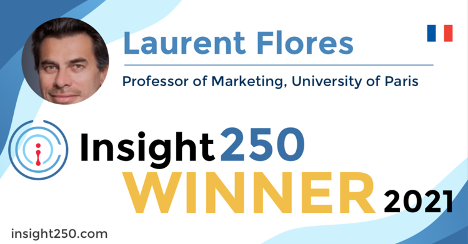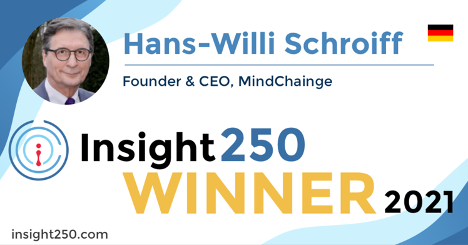
Laurent Flores teaches seminars on traditional and digital marketing, entrepreneurship, personal branding, strategy, statistics, data analysis and marketing measurement. He also serves as an advisor to SLPV analytics. His research has been published in Marketing Science, Decisions Marketing and Journal of Advertising Research. He’s also sat on the boards of ESOMAR, WOMMA and the French Marketing National Association.

Dr. Hans-Willi Schroiff is a marketing and market research academic and practitioner with over 30 years of experience. He is a Professor of Consumer Behavior at the European Business School and Founder and CEO of MindChainge management consultancy. He is also the former Corporate Vice President of Henkel KGaA. He also holds a Ph.D. in psychology.

The Insight250 spotlights and celebrates 250 of the world’s premier leaders and innovators in market research, consumer insights and data-driven marketing. The inaugural list was revealed this April and created renewed excitement across the industry whilst strengthening the connectivity of the market research community.
With so many exceptional professionals named to the Insight250 it seems fitting to tap into their expertise and unique perspectives across an array of topics. This new weekly series will focus on doing just that; inquiring about the expert perspectives of many of these individuals in a series of short topical features.
Previously, this series featured two educational experts, Peter Fader, Professor of Marketing at The Wharton School of University of Pennsylvania and Paul Baines, Professor of Political Marketing & Associate Dean at University of Leicester, discussing educating the next generation of data-driven professionals. Given the interest and popularity of the topic, I sat down with Laurent and Hans-Willi, two more educational experts to gain their insight on the topic.
As markets become increasingly complex and consumers become savvier, preparing professionals to analyse and understand the landscape of business and consumers relies more and more on data-driven approaches and innovation. Laurent and Hans-Willi share their perspectives on a variety of topics surrounding the education and preparation of the next generation of data-driven professionals.
Crispin: Why do you feel it is important for the next generation to embrace innovation and what do you see as the drivers of research innovation over the next few years?
Laurent: “The world has changed so much in a matter of 20 years and marketing and research are no exception. Ask most in marketing and they will tell you their life has changed dramatically, and it will only accelerate. To this end, embracing innovation is absolutely a must. The next generation needs to strive for innovation as a “survival” skill and must be equipped with the right mindset and skills. I strongly believe that “sound theory” and “core fundamentals” are essential to evolve and grow. Educators have an essential role to play to go beyond techniques and provide key conceptual frameworks to understand, analyse and decide.”
Hans-Willi: “There is a famous quote attributed to Peter Drucker, “The only things that count in business are innovation and branding, the rest is costs.” I would definitely support this quote with a messianic sense of mission, today more than ever before. About 60 to 80 percent of all new product launches are no longer on the retailers’ shelves after 12 months. This has not changed since the “digital revolution“ and the success numbers for start-ups are even worse. I observe a growing neglect of the analogue character of the consumer due to the gold rush for anything that is digital. I am not objecting against digitising existing approaches to whatever, but this should not be called “innovation,” but “digitalisation.” Digitising the choice of hair colorations does not add a new and revolutionary variant that truly mesmerises consumers. On the contrary, the real news is missed since companies are so busy digitising the old. I see great opportunities for consumer research that is dealing with new content and not with new formats. Therefore I consider “consumer insights“ and “industry foresight“ as the big opportunities for research in the years to come. Let’s get back to our senses.”
Crispin: Do you feel the next generation of leaders you are teaching are open to innovation and if so how can this be encouraged?
Hans-Willi: “As a wanderer between the two worlds of academia and business practice, my current impression is that there still is a lot of headroom. With the exception probably of the “Marketing Science Institute” (MSI), there are too few bridges being built currently to create fruitful networks between “rigor and relevance.” Academia focuses on scientific publications on tiny issues with a lot of experimental control, largely shooting past the overwhelming problems of business practice. Companies are under more and more pressure to churn out new products, increase profitability and beat the competition in less and less time, with the consequence of substituting sound empirical knowledge by noisy individual judgements. My impression from my courses is that (business) students are fundamentally interested in consumer-centric innovation processes and tools. The dark side of the moon is that, in my opinion, it is taught in just a few places.”
Laurent: “Things have never been so easy and yet so difficult to succeed. The next generation of leaders are not only open to innovation, but strive for it. To this end, the data world offers infinite opportunities to learn and innovate. Again, I believe that the mix of core fundamentals, curiosity, work and passion offer rich and infinite opportunities both to the next generation but to all of us. I personally teach the same core basic skills for years, but context and environment offer renewed opportunities to leverage these skills, learn, and innovate. ”
Crispin: How can universities, students and enterprises work together to most effectively drive innovation?
Laurent: “As a former “research entrepreneur”, I always thought that academia and business had a lot to share. I leveraged “scientific” research to infuse innovation in market research and grow a successful business. It came from the ability to understand core fundamentals and apply them to the business world with technology. Sounds simple but takes time and dedication to build bridges between the academic and business worlds. Their respective agendas may be the same but their time frame and rewards are not totally aligned, it takes people and process to happen. Our role as educators is also to build these skills and inspire students in this direction.”
Hans-Willi: “My eternal dream scenario remains that a company invites a couple of outside academic group members to participate as part of a corporate new product development team. I never had the chance to give it a try, but I continue to be intrigued by the idea. I am very sure that both sides would greatly benefit from this experience. It would require a mutual open mindset, but there would be a better understanding for actual business requirements on the one hand relevance and a better use of scientific and experimental rigor on the other hand.”
Crispin: Do you have any top tips from academia that can help lead to better innovation?
Hans-Willi: “Academia has developed a vast amount of processes and tools to systematically plan observations, put them to test, decide about the “true“ effect and quantify the error/noise in the data. Despite all this powerful support, decision making in corporations continues to be judgment-driven, multiply-biased and thus error-prone. The poor track record of successful new product launches speaks volumes. That needs to be changed quickly. My favorite model here is that of a corporate “integrated innovation management group,” building on the treasure chest of proven research and introducing this wealth of knowledge to design and run a corporate innovation process which is systematic, continuous, empirical, and self-critical.”
Laurent: “I may sound boring but I believe that “sound theory” is key to understanding and growing. As such, rather than focus on the “visible”, we should focus on understanding the underlying fundamentals to analyse, evaluate, and evolve.”
Crispin: Laurent, you were previously President of ESOMAR. Do you feel links with universities are important and what more should ESOMAR do?
Laurent: “I believe they are of course. Next generation leaders are educated in universities but the traditional “marketing research” courses for example should be highly upgraded with the latest techniques and skills coming from the day to day research world. On the other hand, market researchers still need to be taught fundamentals statistics for example to drive sound analysis and decisions. Machines may be quicker, data “bigger”, but smart decisions should remain “human” based striving for the right balance between academia and business.”
Crispin: Are there examples of innovation from your students – past or present – that you’ve been particularly impressed by?
Hans-Willi:“I teach a full-year course on consumer-centric new product development. The course requires six major projects to be run by the students focusing on typical performance facets of the total innovation process. The students’ approaches are tested against corporate real-life solutions of that particular task. It is a bit sad to recognise that master students regularly outperform corporate managers by simply adopting a continuous consumer-focused mindset and a rule-based process to new product development.
“Over 10 years we have worked with a number of companies in Germany and across Europe and we are proud to say that we have enjoyed a major impact on their new product development and particularly the success rate of new launches. I would say that the German company edding (edding AG is a company manufacturing writing and marking tools – ED) sticks out as a kind of poster child here. This is mainly due to the fact that they managed to install a global innovation management unit which is responsible across the company for a continuous innovation pipeline, guaranteeing a sound process, intellectual rigor and deep consumer understanding. I believe this is critical since, unfortunately, we are often out of the door before we recognise what we observe.”
Laurent: “I have the impression that students are more than ever attracted by entrepreneurship. Each year, some of them launch start ups, try to innovate, they learn, fail and succeed. I’m impressed by their ability to quickly roll things out leveraging tools and technology. I have the impression that these skills were not present before, the next generation is surrounded by innovation and embracing it.”
Crispin: Hans-Willi, for many years you have worked internationally. How important is cross-border cooperation for innovation?
Hans-Willi: “Cross-border cooperation is extremely important. However, it requires an undeniable corporate mindset where the affiliate companies abroad are viewed as equal business partners and not as passive recipients of all the “good“ things forced upon them by HQ. This is how the British lost America, by the way. As a consequence, any corporation should be more than open for all types of inputs/ impulses originating from abroad – diversity of input is one of the major prerequisites for being innovative. On the other hand, an equal partnership should also permit diversity of output, i.e. if global taste tests confirm different regional taste preferences, for example orange juice, it would be damaging to insist on “one global formula“ despite all purchasing and production synergies.”
Crispin: What is the “secret sauce” that your University uses to help foster a mindset of innovation?
Laurent:“Attract the best, teach fundamentals and work discipline while fostering an innovative spirit to try new things.”
Hans-Willi: “I think the secret sauce is continuous passive and active consumer orientation. “Passive“ in a sense of continuous observation of consumers, meticulously recording and absorbing the status quo of a market from a buyer’s perspective (what are we seeing now?). “Active” in the sense of continuous extrapolation of this status quo and moving creatively into various innovative directions and creatively developing stunning offers to mesmerised consumers (where is this all moving to and what do we do about it?).
Crispin: HOT TOPIC – In your experience, what are current students’ attitudes to sustainability, mental wellbeing and diversity and inclusion?
Hans-Willi: “In my courses we focus a lot on what really drives consumer decision making and whether “media hypes“ are being transformed into factual purchase behaviour. Without a doubt, the factors you mention are “top of mind“ for basically all population segments. Their impact on purchase decisions however varies (e.g. between product categories). And with age, income, SES and the use of digital media.
“Most of them have a personal attitude towards these factors and are eager to voice and defend them, if required. But I keep telling them that in business settings they need to act deliberately enough not to let their personal values and beliefs interfere with a required neutral business mindset. They understand and I always find this truly remarkable. It demonstrates a lot of respect for the value systems of others – which for me is still one of the pillars of any business context.”
Laurent: “These are present now more than ever and will only continue to grow. We need to also inspire to help them shape a better world indeed.”
TOP TIPS
Hans-Willi: “For readers, Ulrich Lehner, my Henkel CEO for many years, had a great definition for innovation: “Innovation is when the market shouts hoorah.” Quite a general statement, I suppose – but it captures the essence of something really new, distinctive and relevant. The consumer craves it, the trade eagerly supports it, the company prospers, and the shareholders pop the corks. Hoorah!
“For students, try to “walk in their shoes“ – i.e. do everything to adopt the mindset, the living conditions, the value systems, the habit structures etc. of your potential clients and start your innovation journey from there. You will begin to see the world from the only perspective that really matters – the consumer’s view. And then you use your (new) imagination to creatively imagine what could make your new life easier, better, and more beautiful. That’s a good starting point, I believe. You could also attend my courses, but that is the harder route.”
Laurent:“Again, new is good, but there’s nothing so good as a practical theory – embrace innovation but always in the light of a good and practical theory.”


